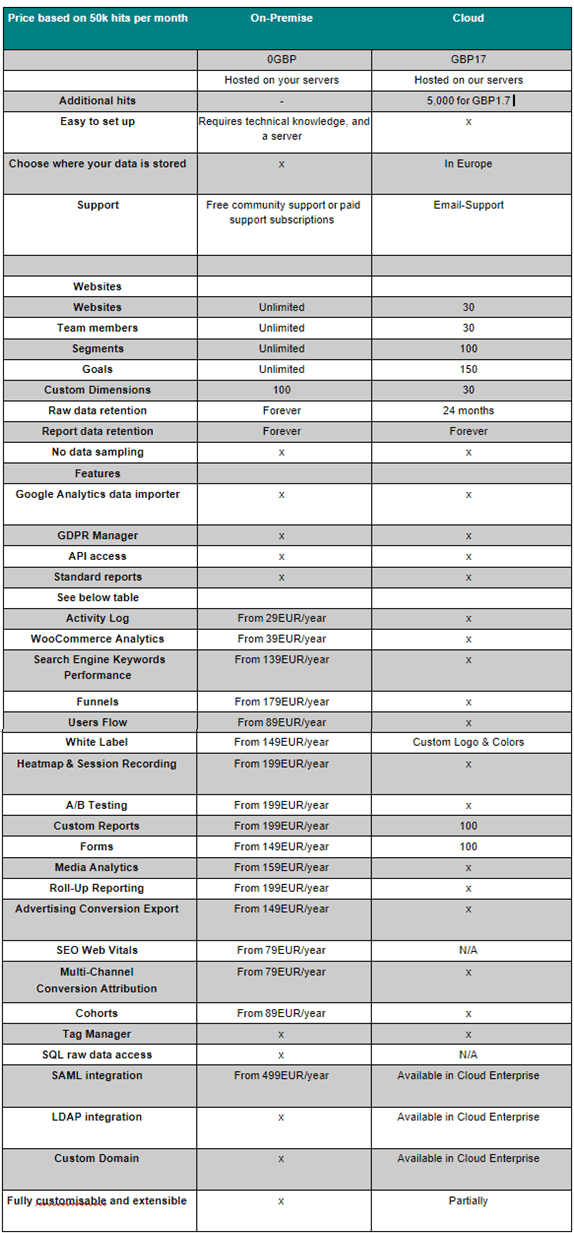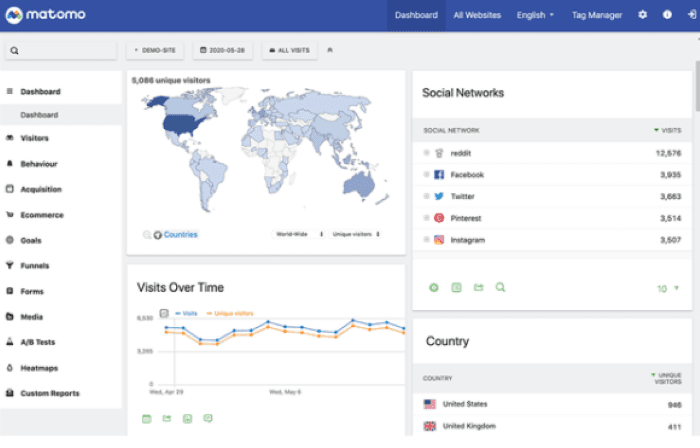Feb 7, 2022
Technology
Marketing
3
min read
Google Analytics 4
Google Analytics 4 (GA4) formerly known as the "App + Web" property is used for tracking websites or mobiles apps, or both, in a single (repository) property.
Released on October 14th, 2020 this tool has quickly grown to attract much attention for the innovation it brings in regards to machine learning and its use of AI to bridge the gaps created in data collection by cookie consent banners. According to Google the latest version is "privacy-centric by design”.
Top features of GA4
ePrivacy and GDPR compliance
Building reliable audiences for ad campaigns
Extra smart user privacy and tracking possibilities
Seamlessly setup goals and events
Enriched visualisation and improved reporting
Extra custom parameters
ePrivacy and GDPR compliance
By default, the previous version of Google Analytics captures and stores user IP addresses. This was unacceptable under GDPR since an IP address is considered a piece of Personally Identifiable Data. Some (prior) GA users altered how GA acquired IP addresses by anonymising the last 3-4 digits.
This arrangement required modifying your tagging code. However, IP anonymisation is automatically enabled in GA4 and can’t be disabled.
Building reliable audiences for ad campaigns
The GA4 platform has new, more robust measures, as well as more sophisticated analyst tools and integrations. The outcome of this is providing a larger audience for marketing campaigns and a higher ROI on ad spending.
Let’s assume you run an ad campaign across mobile and desktop devices. A person visits your site using a mobile browser and completes a contact form; they then return via a desktop computer, using a separate browser, and begin an application form; they eventually complete the application form via your native Android or iOS App.
Until GA4, it would be impossible to optimise ad spending for these types of user experiences. But now you can connect user experiences and prevent wasting your advertising spend if you structure your website and applications appropriately.
Furthermore, Google's new predictive analytics will help companies optimise those audiences even faster and more intelligently. This enables you to establish audiences to target for a higher value return. GA4 helps to better understand why certain website visitors may be more inclined to spend more than others. Knowing why enables you to take appropriate action to drive conversions and profitability.
Extra smart user privacy and tracking possibilities
Google Analytics 4 provides more intuitive and precise control over what kind of personal data is gathered. This intuitiveness helps you comply with GDPR privacy rules. For example, you can remove particular events and user data from ad personalisation.
This new method is more flexible and adaptive to a future ‘cookieless’ world where privacy will become an increasingly important issue for users and regulators.
Seamlessly setup goals and events
Google refers to this as 'Event Altering and Synthesis.’ It allows you to fine-tune goal tracking and get detailed behavioural data with the little-to-no need for editing code or optimizing goal setup.
Some form submission and e-commerce objectives may not be monitored automatically, but setting them up is now a lot simpler and takes considerably less time to develop than in earlier GA versions.
Enriched visualisation and improved reporting
While most of the platform's UI has remained relatively unchanged, there are some new and improved visualisations and reporting tools. For instance, existing visualisations like 'Real Time' are more interesting. But it's the new tools that are a game-changer.
The 'Analysis Hub’ includes a template gallery where you can build custom charts, such as Exploration, Funnel Analysis, Segment Overlaps, and Route Analysis. This advanced feature helps in the simplification of more sophisticated cross-dimensional metrics reporting.
Extra custom parameters
When it comes to analytics, having the correct data and granularity for key KPIs is critical to extracting value from them. Having more data doesn’t necessarily imply better data. But having the right parameters in place is advantageous.
As stated by Google, you may provide parameters with each event using this version. Parameters are extra pieces of information that may be used to better define the action taken by the user or to give context to the event.
For example, it may be used to indicate the purchase price. Some parameters, such as page title, are automatically sent.
In addition to the data that are automatically recorded, you may log up to 25 parameters with each occurrence.
This new and improved GA4 is a re-architecture of the platform we know and love, with a plethora of features and advantages. While GA4 is still in its infancy, it’s constantly being improved.
Summary of GA4 benefits
Customer tracking along the journey is improved
Improved analysis of user involvement
A high performing cross-platform tool
More valuable viewers for your advertising efforts
Improved user privacy
Goals and event tracking setup is simplified
Visualisations and reporting have been improved
A wide variety of parameters
Matomo Analytics
Matomo Analytics, previously Piwik, is available as a free (GPL-licensed) web analytics tool (on-premise) or as a paid for cloud hosted service.
It’s open-source software that allows enterprises to retain complete ownership and management of their data, making it a popular option. A comparison of the on-premise and cloud hosted options is shown below:

Top features of Matomo Analytics
GDPR and ePrivacy compliance
Real-time data insights
Heatmaps
Session recording
Funnels
Form analytics
GDPR and ePrivacy compliance
Matomo is capable of being configured to automatically anonymise data, ensuring that no personal information is processed by the providers. If you choose to handle personal data, Matomo walks you through 12 simple steps to effortlessly comply with GDPR and ePrivacy standards.
Real-time data insights
What distinguishes Matomo from other tools of this kind is that it is especially useful for evaluating real-time data. Matomo has a plethora of data that can pinpoint where traffic is “happening” on a website at any given moment. For direct marketing, Matomo is ideal for determining the efficiency of your marketing activities.
Some of the most valuable features that Matomo provides are not included in the free download but are accessible through two sources:
Matomo cloud service
Paid third-party plugin
With Matomo you can see data on each unique visitor. For example, ID, operating system, browser, and time spent details about their activities, and more. A user's real activities may also be tracked.
This may be useful for monitoring visitors who may have visited your site many times, as well as identifying potential pain points to increase conversions.
Heatmaps
Heatmaps are visual representations of where people click on a website. They reveal the true patterns of visitor activity on your website.
Matomo's heatmap function will help you understand how your visitors are engaging with your web pages. This feature allows you to see scroll maps and clicks in impressive overlay reports.
Session recording
Matomo has a very useful feature that allows you to follow individual users as they browse your website. You'll not only be able to record all the pages visited, you’ll also see the whole of their journey, including mouse movement, scrolls.
Funnels
Many marketing campaigns will have a set of expected steps that you want users to take.
Matomo enables you to design pre-defined flows, or funnels, with a series of brief objectives, such as a process from clicking on a promotional ad to adding items to a shopping cart; determined by the number of steps.
These funnels allow marketers to add markers for each stage. This makes it easy to follow activity across a marketing campaign. This also helps with understanding user behaviour, as it determines when a user may drop off during their journey.
Form analytics
One of the most difficult components of managing ecommerce processes on a website is dealing with forms. Typically, to get critical information about your visitors you must rely on them to offer it to you.
Forms can cause usability issues for users. Tracking how people use them may assist with information that can make or ruin a marketing strategy.
Matomo's form analytics can monitor user progress through a form, including those that left a site during the completion process, the percentage of those who finished the form, time spent completing the form, and even hesitations made by users before submitting.
Summary of Motomo benefits
One significant advantage of adopting Matomo instead of Google Analytics is that it provides organisations with full ownership and privacy control for all analytical data acquired, stored, and processed.
All information is physically kept on your servers to comply with ePrivacy and GDPR. As a result, businesses can comply with any new legislation more effectively and quickly.
In big projects, Matomo is a good option over Google Analytics Premium because, regardless of how high the server expenditures are, they’ll always be cheaper than the cost of the Google tool since you are given unrestricted storage on your server
Complete control over data
Because it’s free open-source, you can tweak its functions with codes
No limit to the amount of data that may be exported
In terms of privacy, Matomo uses first-party cookies to ensure user data is not disclosed to third parties
A native alternative for complying with European cookie policies
How to install GA4 using Google Tag Manager
Google rebranded its App+Web properties to Google Analytics 4 in late 2020. This implies that the default property will now be GA4. Compared to the previous version it’s a whole new platform. It has a new interface, new Google Tag Manager, new data model, and more.
Using Google Tag Manager, Google Analytics 4 can be installed. Be aware that GA4 is cloud-based and can’t be installed on your desktop.
Follow these steps to install Google Analytics 4 using Google Tag Manager:
Create a new GA4 property
Create a data stream
Copy the Measurement ID
Create configuration tag for Google Analytics 4
Paste the Measurement ID and set the tag to fire on every pages
Preview and test the new tag
Publish your changes in the Google Tag Manager
How to install Matomo Analytics
Unlike Google Analytics 4, which is cloud-based, Matomo is available in two variants:
Matomo Cloud
Matomo on-Premises
Installing Matomo Cloud
The procedure for installing Matomo Cloud is identical to installing Google Analytics.
Installing Matomo Cloud
The procedure for installing Matomo Cloud is identical to installing Google Analytics.
But before utilising Matomo Cloud you'll need to create a Matomo account. To create an account, provide your website URL, email address, and analytics subdomain.
After registering, you'll receive an email confirmation. They’ll provide you with your Matomo login information as well as your site's Matomo subdomain. Below that, you’ll also find a tracking code.
Using Google Tag Manager, the Matomo tracking code will be deployed across every page on your website. This service is not free as you must pay to host Matomo in the cloud.
Installing Matomo on-Premises
If you prefer to use Matomo for free, you must install the open-source software. You'll need to host the Matomo software on your servers for this option. As a result, you'll need to guarantee that you have your web server and access to it through shell or FTP.
You'll also need a solid grasp of the ability to utilise web apps. Matomo on-premise installation will require some back-end technical work. If you’re not a web developer, you may engage the services of a professional to install Matomo for you. After the installation is complete, you’ll be given a tracking number that you must enter on your site.

Conclusion
Matomo is a powerful online analytics software with a wide range of features that most marketers would like to use to evaluate web traffic, campaigns, and user activity on their websites. Matomo is a good alternative to Google Analytics for businesses wishing to keep complete control over their data.
As it’s open-source it is more flexible to being tailored to specific requirements.
Matomo stands out with real-time analytics. This allows you to monitor live activity on your website. Conversion optimisation tools like heatmaps, form analytics, and funnels may be useful for many direct marketing businesses that want to see how well specific campaigns are doing when the user reaches the point of sale.
If privacy and data ownership are important considerations Matomo stands out. Conversely, Google Analytics remains the most used online analytics tool. GA4 is more adaptable than Matomo since it serves as a tool for both a website and mobile phone apps. GA4 places a strong emphasis on the user's journey.
The user interface in GA4 is substantially more user-centered. GA4 incorporates predictive analytics capabilities.
Working with Codehouse
At Codehouse, we have a dedicated team of experts that will guide you through your analytics journey, no matter which platform you use.
Our Digital Experience team has helped many customers get the very best from their analytics. To find out more about how we can help with your website's performance, or if you need help understanding how to get the best out of GA4, Matomo and other marketing configurations, get in touch.
Images sourced from Google Analytics and Matomo Analytics








